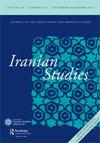两种拉吉方言与波斯语融合:对接触影响的对比反应
IF 0.9
4区 社会学
Q2 AREA STUDIES
引用次数: 0
摘要
拉吉语是伊朗伊斯法罕省西北角的卡尚地区使用的一种中央高原(伊朗)语言。在这里,我们调查了波斯语对两种密切相关的拉吉语方言词汇的影响:阿布泽伊达巴德语,海拔947米的沙漠前哨,以及巴尔佐克语,海拔2080米的附近山区一个水分充足的农业社区。正如预期的那样,我们的分析表明,由于三个伊朗变体之间的语言关系,许多遗传相似性;区别他们的差异和创新案例;以及波斯语对两种拉吉方言的深刻影响。尽管如此,与波斯语融合的程度和模式是不平衡的,Abuzeydabad方言显示出更多的大规模借用波斯语,以及结构杂交的证据。为了解释波斯影响的不同影响,我们回顾了语言接触情况下的社会和地理动态。人口、与邻近的波斯语城市卡尚的距离、语言认同以及媒体和教育的影响等关键因素都是相同的。然而,城镇地理环境之间的鲜明对比决定了它们的社会网络和流动模式,以及每种语言代码的使用者如何回应波斯的影响。本文章由计算机程序翻译,如有差异,请以英文原文为准。
Two Raji Dialects Converge with Persian: Contrasting Responses to Contact Influence
Raji is a Central Plateau (Iranic) language spoken in Kashan district, in the north-west corner of Esfahan Province, Iran. Here, we investigate the nature of Persian influence on the lexicon of two closely-related Raji dialects: that of Abuzeydabad, a desert outpost at 947m above sea level, and Barzok, a well-watered farming community at 2080m in mountains nearby. As expected, our analysis shows many inherited similarities due to linguistic relationship among the three Iranic varieties; cases of difference and innovation that distinguish them; and profound impact of Persian on both Raji dialects. Nonetheless, the degree and patterning of convergence with Persian is uneven, with the dialect of Abuzeydabad showing greater wholesale borrowing from Persian, as well as evidence of structural hybridization. To account for the divergent effects of Persian influence, we review social and geographic dynamics in the language contact situation. Key factors such as population, distance from the nearby Persian-speaking city of Kashan, language identity, and the impact of media and education are equivalent. However, a stark contrast between the towns’ geographic settings defines their social networks and patterns of mobility, and in turn how speakers of each linguistic code respond to Persian influence.
求助全文
通过发布文献求助,成功后即可免费获取论文全文。
去求助
来源期刊

Iranian Studies
Multiple-
自引率
0.00%
发文量
92
期刊介绍:
Iranian Studies is a peer-reviewed journal devoted to Iranian and Persian history, literature, and society, published on behalf of the Association for Iranian Studies . Its scope includes all areas of the world with a Persian or Iranian legacy, especially Iran, Afghanistan, Central Asia and the Caucasus, and northern India, and Iranians in the diaspora. It welcomes submissions in all disciplines.
 求助内容:
求助内容: 应助结果提醒方式:
应助结果提醒方式:


